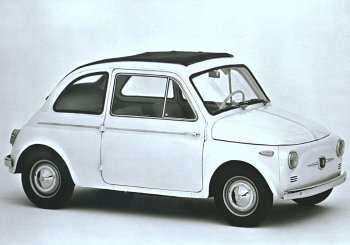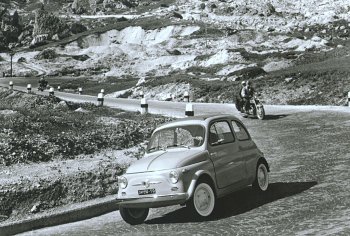|
Some cars go down in history for their technological or stylistic innovations. Others deserve to be remembered for the role they have played in the daily life
of an entire generation or an entire country. Few succeed in combining the two:
technology and sentiment. They leave an indelible mark, becoming a sort of icon
of their age.
The Nuova 500 is one of these. In a career lasting 18 years, from
1957 to 1975, exactly 3,893,294 were built, and it helped Italians and numerous
other Europeans to satisfy the need for individual mobility that began to gain
momentum from the early 1950s. The Nuova 500, even more than the 600 (1955),
also brought the end of the post-war emergency period for motorisation and the
automotive industry in Italy, and the start of the striving for comfort, albeit
minimal and economical. With the Nuova 500, and its four popular wheels, the
country of the Poor
but beautiful became, or tried to be, not quite as poor (and to a certain extent it
succeeded), but above all, able to move around more freely.
The Nuova 500 also concluded the rebirth of Fiat and of its product range, after
the devastation of the Second World War. Dante Giacosa, the father’
of the Nuova 500, but also of the previous 500 Topolino and of numerous other
models, said in his book ‘Progetti
alla Fiat prima del computer' (Design
at Fiat before the computer), that when the 500 was launched on July 4, 1957,
Fiat ‘realised its programme of renewing its models, to replace those born
before the Second World War’.
At
two-year intervals, the Fiat 1400, 1900, 1100 – 103, 600, Nuova 500 and their
model derivatives were launched on the international market. In just 10 years, Fiat
had conceived and begun manufacture of four completely new
basic models that had their roots in the technological
culture that had grown up in its own offices and
laboratories. No Italian or foreign model influenced the
development of these projects.
|
 |
|
The Nuova 500, even more than the 600 (1955), also
brought the end of the post-war emergency period for
motorisation and the automotive industry in Italy,
and the start of the striving for comfort, albeit
minimal and economical. |
|
|
 |
|
In a career lasting 18 years, from 1957 to 1975,
exactly 3,893,294 Fiat 500s were built, and it
helped Italians and numerous other Europeans to
satisfy the need for individual mobility that began
to gain momentum from the early 1950s. |
|
|
It may seem overly emphatic to underline this fact today, but it
was utterly comprehensible at the time, in the late 1940s and 1950s, when Lancia
and Alfa Romeo both operated autonomously in Italy and were therefore Fiat’s
competitors, whereas abroad, in Germany, and above all in the United States, the
domestic industry still seemed to be one step ahead in many ways.
Dante Giacosa also wrote about the launch of the Nuova 500 and said that the
‘Press
Office, run by Gino Pestelli assisted by the hyperactive Mariuccia Rubiolo,
wanted me to collaborate on the advertising launch’.
Once the name ‘Nuova 500 had been chosen to recall the famous Topolino’,
the message soon followed, with a slogan that claimed: ‘twenty
years after the original 500 (the Topolino was launched in 1936), on a similar
wave of success, here comes the Nuova 500, completely new, modern, less
expensive, more economical, a worthy successor to the world’s first runabout,
built by Fiat’. Giacosa also revealed
that the term ‘Big little car’ was also coined at Mirafiori, but the pragmatic engineer commented that
‘people just called it the 500’.
Fifty years after that Summer of 1957, in an age when television is even
available on mobile phones, with shots and reports from all over the universe,
it is entertaining to read that ‘the
launch was held in great style. National television installed itself in
the Mirafiori workshop on a boiling hot evening in July, and even I was
invited for a live interview on the assembly line.’
18 years after that ‘boiling
hot evening in July’, during which
time almost 3.9 million cars were built, another very hot day dawned, August 4,
1975, the day on which the ‘last’
car, at least of the 1957-75 Nuova Fiat 500 series, was built, not at Mirafiori
but at the SicilFiat plant in Termini Imerese (Palermo).
|
|
|
|